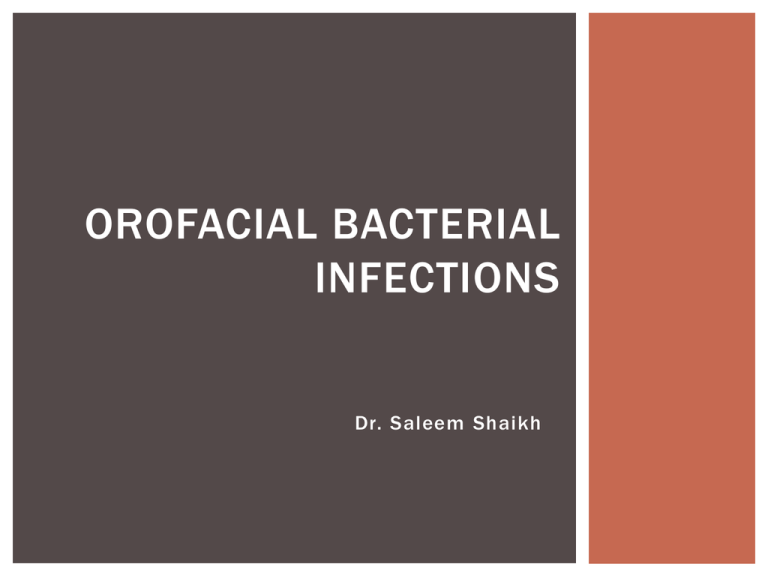oral microbiology - bacterial infections
advertisement

OROFACIAL BACTERIAL INFECTIONS Dr. Saleem Shaikh INTRODUCTION Oral cavity contains a rich and diverse microflora Small alterations in the local environment can produce microbial population changes that permit the development of opportunistic infections involving bacterial species that are usually regarded as non pathogenic. Strict anaerobes form the major proportion of microflora in acute suppurative infections. Gram negative anaerobic bacteria are the most predominant and in most cases the pathogens in such infections. Orofacial bacterial infections may present either as a localized abscess or dif fuse cellulitis depending on the virulence of bacteria, local anatomic structures and host defense mechanisms. These may lead to septicaemia An abscess is hypertonic in relation to its surroundings and pressure ef fects lead to bone resorption, in dentoalveolar abscess perforation of the bone may spread the infection to surrounding soft tissue which leads to cellulitis. ANTIMICROBIAL SUSCEPTIBILIT Y Global emergence of antibiotic resistance is of great concern, previously 3-4 % isolates showed penicillin resistance but now 38-42% show penicillin resistance. Molecular techniques have been developed to permit rapid detection of penicillin resistance genes in pus specimens this may prove to be very beneficial in clinical management if they are more widely available. The emergence of beta lactamase producing bacteria is said to be the most important cause for penicillin resistance. Clindamycin has shown extremely low incidence of resistance, even in countries where it is frequently used. ENDODONTIC INFECTION The presence of microorganisms in root canals prior to and during treatment is widely studied. The microflora seen are very similar to that of acute dento alveolar abcsess 7-20 dif ferent species are frequently seen in the root canals – Olsenella profusa, P. gingivalis, Dialister spp and anaerobic streptococci. Enterococcus faecalis has been proposed to be associated with endodontic failures. T. denticola has been implicated as the cause of disseminating infection from the root canal to dif ferent organs. LATERAL PERIODONTAL ABSCESS It is associated with a vital pulp Develops usually as a result of blockage of in an established periodontal pocket due to presence of a foreign object Pus discharge may be seen from the gingival margin Porphyromonas spp, Prevotella spp, fusobacterium spp, actinomyces spp, capnocytophaga spp, haemolytic streptococci are seen commonly Drainage and irrigation with an antiseptic mouthwash is indicated. Antibiotic therapy is rarely required. ACUTE DENTOALVEOLAR ABSCESS This is the most frequently occurring orofacial bacterial infection. Develops usually due to spread of infection from the necrotic pulp. It may also spread from the periodontal ligament or from the blood vessels [anachoresis]. It may also develop from a chronic lesion, the mechanism for change from chronic to acute suppurative lesion are poorly understood, it could be because of occurrence of specific combination of bacteria or due to sudden provision of nutrients via local tissue damage. Microflora is polymicrobial, streptococci group is predominant, Porphyromonas spp, Prevotella spp, fusobacterium spp, actinomyces spp, are also seen Drainage – antibiotics [amoxicillin, metronidazole, clindamycin] CELLULITIS – LUDWIG’S ANGINA Dif fuse spread of infection in the soft tissues, Spread of infection to spaces of the face may lead to dif ficulty in swallowing. Ludwig’s angina – involvement of sunmandibular, sublingual and submental spaces bilaterally. Porphyromonas spp, Prevotella spp, fusobacterium spp, actinomyces spp, capnocytophaga spp, haemolytic streptococci are seen Immediate referral to a specialist is recommended, hospitalization permits use of intravenous antibiotics. Initial treatment must include broad spectrum antibiotics – ceftriaxone and metronidazole combination. OSTEOMYELITIS It is infection and inflammation of the bone or bone marrow. May be acute or chronic Treatment is local debridement and topical anesthetic of exposed areas. Clindamycin is the drug of choice due to its ability to achieve therapeutic levels in the bone. DRY SOCKET Extremely painful form of alveolar osteitis. Caused due to fibrinolysis of the blood clot. Strict anaerobes have been implicated in this infection Metronidazole is the drug of choice. Pericoronitis Inflammation of soft tissues covering or immediately adjacent to the crown of a partially erupted tooth. Prevotella intermedia, fusobacterium spp, anaerobic streptococci are seen . Recent studies have shown A .actinomycetecomitans also. Local irrigation, operculectomy Severe cases may require antibiotics – amoxicillin and metronidazole. Bacterial sialadenitis Bacterial infection principally caused by staphylococcus aureus, seen due to presence of underlying xerostomia. Other bacteria may be haemophilus spp, eikenella corrodens, prevotella spp. Amoxicillin or erythromycin. ANGULAR CHELITIS Inflammation which is localized to the angles of the mouth, Caused by staphylococcus aureus or candida spp either alone or together. Staphylococci are seen commonly in dentate patients whereas candida is seen more in patients with dentures or orthodontic appliances. The reservoir of staphylococcal infection is anterior part of the nose and oral cavity for candida. Fusidic acid cream is used for stapylococcal infection. Miconazole cream is used in uncertain cases as this is effective against both candida and bacteria. ACTINOMYCOSIS Caused by actinomyces genus Sulphur granules A. Actinomycetemcomitans, Haemophilus spp, propionibacterium spp




